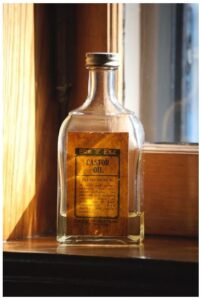Vis Medicatrix Naturae
Marisol Teijeiro, ND
Like any good legend, the story of castor oil throughout the ages is one of ebbing and flowing, but mainly one of adapting into the common medical practices of the time. From the glory years in ethnobotanical and cultural medicine to the dark ages of fascist governments, castor oil has seen it all because of its historic reach into all areas of the world. This oil has been proven, time and time again, for its effectiveness in taking care of our health – beginning with its indigenous roots in India, the Mediterranean Basin, and Eastern Africa, and then spreading across the world with trade.
Medicinal & Cosmetic Uses Thru the Ages
The roots of castor oil usage run very deep in terms of human evolution. This plant has been with us since the beginning of our time on earth, walking as upright humans. Archaeological excavation of ancient Egyptian tombs has revealed the use of castor oil in oil-fired lamps as far back as 4000 BC. It is also referred to in Egyptian hieroglyphics dating before Christ.1

Dating back to 2000 BC,2 the ancient medical treatise known as the Ebers Papyrus discusses the use of castor oil as a laxative. Additionally, castor oil was detected as an embalming material on a Ptolemaic mummy dating back to 100 BC.3 It was even suggested that Cleopatra, herself, was a big fan of castor oil and that she used it to help with the whitening of her eyes, although this remains to be confirmed.
The Ancient Romans called castor oil “oleum cicinum.” Like the Egyptians, their uses of it were both cosmetic and medicinal. According to the Roman naturalist, Pliny the Elder (AD 23), castor oil was very effective for joints, the uterus, the ear, and the skin, to improve complexion, scabs, and burns.4
Among the Ancient Greeks, Herodotus discussed the use of castor oil in body ointments for lightening the skin and improving hair growth and texture.5
Many ethnobotanical medicine systems have a deep connection with castor oil. In Haiti, they call the oil “maskreti,” and it is processed before use to give it a red color. Here it is used to help newborns expel their first stools.6
It is common practice, as reported by so many of my patients in Caribbean and Indian cultures, to give children a spoonful of castor oil weekly as an intestinal de-worming and anti-parasitic substance. For some, it was a remedy for bad behavior in children, depicted in the well-known short animated film, Tom and Jerry, in an episode entitled “Baby Puss,” produced by Fred Quimby and released by Metro-Goldwyn Mayer on December 25, 1943.

In South India, castor oil is used as a traditional eye medicine for corneal ulcers.7 Ayurvedic medicine calls castor oil “eranda” and considers it the king medicinal for arthritic complaints and abdominal pains.8
In China, castor oil and its seed derivatives have been used for centuries internally or as a topical dressing.
Abuse of Castor Oil
The Dark Ages in the history of castor oil’s usage was the abuse of it in Italian and Spanish societies. In 18th century Spain – a time recognized for overindulgence of food and drink – it was common for people to experience “empacho,” translated as indigestion, or gastrointestinal issues. In this era, the practice was to use castor oil as a stimulant laxative, to cleanse oneself after excessive indulgence.9

Many Italians have an immediate aversion to castor oil due to the cultural references of fascist Mussolini, who used castor oil as a torture tool. Prisoners would be force-fed castor oil to get them to divulge their secrets. For many, this resulted in death from loss of electrolytes; it also gave castor oil a bad reputation in this culture.10
Worldwide & Multicultural Usage
Many different cultures around the world have experience with castor oil, or at the very least know what it is. I’ve had Russians, Turks, Persians, and so many others tell me about their cultural uses of castor oil, similar to those mentioned above.
As we evolved into nations united, multicultural melting pots like the United States and the multicultural mosaics of my country, Canada, were formed. In the early part of the 20th century, castor oil appeared on pharmacy shelves along with 3 other common herbs: senna, ipecac, and the astringent, witch hazel.
Popularization of the Castor Oil Pack
In the early 1900s, Edgar Cayce put castor oil on the map as a healing agent in North America, specifically known as the castor oil healing pack. Cayce was a renowned “bedside healer” and used packs saturated in this healing oil as his most important treatment, no matter the condition or ailment.11 Naturalists, naturopathic doctors, herbalists, and other alternative health promoters adopted these packs into their practice.
With the rise of health food stores in North America in the 60s, castor oil became a staple. One will always find castor oil in a health food store.
Investigations into Its Mechanism of Action
In the late 1970s, the Mayo clinic began active investigation into the unique triglyceride found in castor oil: ricinoleic acid. Specifically, investigators researched the effect of this triglyceride chain on the surface of the intestine12 as well as its effect on water and electrolytes.13
That this remarkable oil was being used for nearly everything encouraged both speculation and mysticism surrounding it. How could a single oil have so many applications? Some in the conventional world began to shun it, while others embraced it wholeheartedly.
Castor Oil Usage in Conventional Medicine
A nurse, who is also one of my patients, reported that in her early years in the hospital, back in 1987, they were using the castor oil pack in the labor and delivery department. As another example, a few months ago one of my patients followed my recommendation to do a castor oil pack post-hip surgery, directly on the area, to speed up healing and lessen the pain. Her physiotherapist made the same recommendation, noting that he had learned it from top orthopedic doctors who also used the packs for speedier repair post-surgery.
Castor Oil Usage in Pharmaceuticals
What an incredible history this oil has and continues to create. I urge you to open up the conversation about all of its uses with your patients. Or delve into a quick search on PubMed and you’ll see many other examples, including its use in a proprietary solubilizing carrier for essential oils or the fat-soluble vitamins A, D, E, and K.14 It is also used in a number of pharmaceutical drugs, for example, the topical antifungal, miconazole; the oral anti-cancer drug, paclitaxel15; and IM/IV forms of diazepam.16
You can also find castor oil being researched for use as a bowel preparation for colonoscopies,17 listed as one of the main ingredients used in a proprietary ointment for decubitus and varicose ulcers,18,19 used in periodontal medicine as a biofilm reducer,20-22 and even used in industry as a polyester.23 The list goes on and on.
Castor Oil Bottled in Plastic vs Glass
When using castor oil therapeutically, it is very important to only use castor oil that is 100% pure, cold-pressed, hexane-free, and certified organic. It also must be bottled in glass, not plastic. Since castor oil is an excellent carrier oil, the potential of plastic chemicals being absorbed into it is high. Even BPA-free plastics contain chemicals that can be detrimental to the hormonal, nervous, and immune systems, such as slip agents like nonylphenol24 and UV filters like benzophenones.25
Castor Oil’s Legend Lives On
My sense is that this oil will somehow always find its place in our lives, no matter the adversity or the negative appeal of how it looks, feels, and smells. Those that use the oil and have reaped the benefits are enamored with it. If you haven’t yet experienced castor oil, I urge you to start today. Stay tuned for upcoming articles in which we discuss the cosmetic uses of castor oil and the castor oil pack.
Conflicts of Interest: Dr Marisol Teijeiro is a naturopathic doctor and has a financial interest in Queen of the Thrones Inc™ – creators of castor oil packs, products, and online education.
Read part 1 here
Read part 3 here
References:
- Copley MS, Bland HA, Rose P, et al. Gas chromatographic, mass spectrometric and stable carbon isotopic investigations of organic residues of plant oils and animal fats employed as illuminants in archaeological lamps from Egypt. Analyst. 2005;130(6):860-871.
- Tunaru S, Althoff TF, Nüsing RM, et al. Castor oil induces laxation and uterus contraction via ricinoleic acid activating prostaglandin EP3 receptors. Proc Natl Acad Sci U S A. 2012;109(23):9179-9184.
- Tchapla A, Méjanelle P, Bleton J, Goursaud S. Characterisation of embalming materials of a mummy of the Ptolemaic era. Comparison with balms from mummies of different eras. J Sep Sci. 2004;27(3):217-234.
- Bostock J. Chapter 41—Castor Oil: Sixteen Remedies. In: Pliny the Elder, The Natural History. Available at: http://www.perseus.tufts.edu/hopper/text?doc=Perseus%3Atext%3A1999.02.0137%3Abook%3D23%3Achapter%3D41. Accessed August 5, 2019.
- Coonen LP. Herodotus on Biology. The Scientific Monthly. 1953;76(2):63-70. Available at: https://www.jstor.org/stable/20629?seq=1#page_scan_tab_contents. Accessed August 5, 2019.
- Quiros-Moran D. Guide to Afro-Cuban Herbalism. Bloomington, IN: AuthorHouse; 2009: 347.
- Prajna NV, Pillai MR, Manimegalai TK, Srinivasan M. Use of Traditional Eye Medicines by corneal ulcer patients presenting to a hospital in South India. Indian J Ophthalmol. 1999;47(1):15-18.
- Scarpa A, Guerci A. Various uses of the castor oil plant (Ricinus communis L.). A review. J Ethnopharmacol. 1982;5(2):117-137.
- Campos-Navarro R, Coronado ML. The empacho in Mexico during the nineteenth century. Rev Med Inst Mex Seguro Soc. 2009;47(3):243-250. [Article in Spanish]
- Bosworth RJB. Mussolini. New York, NY: Bloomsbury Academic; 2002.
- McGarey The Oil that Heals: A Physician’s Successes with Castor Oil Treatments. Virginia Beach, VA: A.R.E. Press; 1994.
- Gaginella TS, Phillips SF. Ricinoleic acid (castor oil) alters intestinal surface structure. Mayo Clin Proc. 1976;51(1):6-12.
- Gaginella TS, Stewart JJ, Olsen WA, Bass P. Actions of ricinoleic acid and structurally related fatty acids on the gastrointestinal tract. II. Effects on water and electrolyte absorption in vitro. J Pharmacol Exp Ther. 1975;195(2):355-361.
- J Biomed Mater Res A. 2008;84(3):740-752. Smolinske SC. CRC Handbook of Food, Drug, and Cosmetic Excipients. Boca Raton, FL: CRC Press; 2018: 279.
- Petrelli F, Borgonovo K, Barni S. Targeted delivery for breast cancer therapy: the history of nanoparticle-albumin-bound paclitaxel. Expert Opin Pharmacother. 2010;11(8):1413-1432.
- Cremophor® EL Castor Oil. In: Pharmaceutical Technology of BASF Excipients. June 2008. Available at: https://www.academia.edu/8819789/Pharma_Ingredients_and_Services_Cremophor_EL_Castor_Oil. Accessed August 5, 2019.
- Ohmiya N, Hotta N, Mitsufuji S, et al. Multicenter feasibility study of bowel preparation with castor oil for colon capsule endoscopy. Dig Endosc. 2019;31(2):164-172.
- Venelex Ointment. [Package insert]. Available at: https://tinyurl.com/yxwf54ve. Accessed September 3, 2019.
- McDougall CJ, Franklin LE, Gresle SO. Management of radiation dermatitis in a patient after mastectomy. J Wound Ostomy Continence Nurs. 2005;32(5):337-339; discussion 339-340.
- Andrade IM, Andrade KM, Pisani MX, et al. Trial of an experimental castor oil solution for cleaning dentures. Braz Dent J. 2014;25(1):43-47.
- Salles MM, Badaró MM, Arruda CN, et al. Antimicrobial activity of complete denture cleanser solutions based on sodium hypochlorite and Ricinus communis – a randomized clinical study. J Appl Oral Sci. 2015;23(6):637-642.
- Badaró MM, Salles MM, Leite VMF, et al. Clinical trial for evaluation of Ricinus communis and sodium hypochlorite as denture cleanser. J Appl Oral Sci. 2017;25(3):324-334.
- Kunduru KR, Basu A, Haim Zada M, Domb AJ. Castor Oil-Based Biodegradable Polyesters. Biomacromolecules. 2015;16(9):2572-2587.
- Kim H, Oh S, Gye MC, Shin I. Comparative toxicological evaluation of nonylphenol and nonylphenol polyethoxylates using human keratinocytes. Drug Chem Toxicol. 2018;41(4):486-491.
- Amar SK, Goyal S, Srivastav AK, et al. Combined effect of Benzophenone-2 and ultraviolet radiation promote photogenotoxicity and photocytotoxicity in human keratinocytes. Regul Toxicol Pharmacol. 2018;95:298-306.
 Marisol Teijeiro, ND, is the director of Sanas Health Practice, in Petersburg, Ontario. Her focus is on cleansing and gut health, and she’s appropriately been dubbed the Queen of the Thrones™ by her patients as she’s helped thousands overcome digestive issues and take control of their toilet troubles. She has spearheaded the Queen of the Thrones™ line of lifestyle entrainment products that includes an easy, mess-less castor oil pack and castor oil in a glass bottle. Dr Marisol speaks internationally at educational conferences for practitioners, teaches a course on castor oil at CCNM, and will be releasing her debut guide book on digestive health, Oh Sh*t, later this year.
Marisol Teijeiro, ND, is the director of Sanas Health Practice, in Petersburg, Ontario. Her focus is on cleansing and gut health, and she’s appropriately been dubbed the Queen of the Thrones™ by her patients as she’s helped thousands overcome digestive issues and take control of their toilet troubles. She has spearheaded the Queen of the Thrones™ line of lifestyle entrainment products that includes an easy, mess-less castor oil pack and castor oil in a glass bottle. Dr Marisol speaks internationally at educational conferences for practitioners, teaches a course on castor oil at CCNM, and will be releasing her debut guide book on digestive health, Oh Sh*t, later this year.


